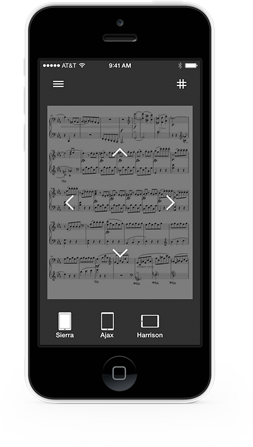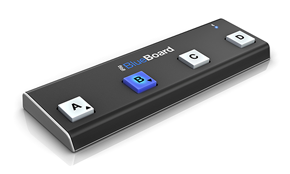Since its inception, forScore has always been about removing barriers between musicians and their music. Today we’re happy to announce the latest update to forScore, version 7.1, and we think it’s a big step forward for that core mission.
For many musicians, cloud-based file storage is an essential part of their workflow, and it became clear early on in forScore’s development that Dropbox was used by a huge majority of these musicians. Since then, however, the file services market has shifted and there’s no right choice for everyone (and sometimes no choice at all, like for many students).
With that in mind, we’ve replaced forScore’s Dropbox panel with an entirely new Services feature that lets you use your Dropbox, Google Drive, Microsoft OneDrive, or Box account, and connect to any number of FTP or WebDAV servers—more options than any other music reader we know of. Completely rebuilt and backed by an entirely new architecture, it’s more reliable and usable than ever before: search the current directory, create and manage folders, and sort lists by filename or date modified.
Completely rebuilt and backed by an entirely new architecture, it’s more reliable and usable than ever before: search the current directory, create and manage folders, and sort lists by filename or date modified.
We also set out to fix a common usability issue when working with a large number of file transfers: errors. Many apps simply alert you every time something goes wrong, and if your network drops out while transferring dozens of files, you might be stuck dismissing dozens of popup alerts. Instead, we created a log view that lists your communications with the server and lets you see the status of each. You can even retry canceled or failed transfers with just a few taps.
We know this has been on a lot of people’s wish lists for a long time now and we think getting it right was worth the wait. Version 7.1 is available immediately on the App Store and still absolutely free for existing users or just $6.99 (USD) for newcomers, so be sure to check it out!
Via Apple:
Choral Singing with iPad: forScore and Essential Voices USA
Join forScore developer Isaac Watson and Judith Clurman’s Essential Voices USA to learn how you can get the most out of your iPad when rehearsing and performing music. See the newest features and watch singers from Essential Voices USA demonstrate how they perform using forScore for iPad—a sheet music reader used by musicians all over the world.
We’re very excited to announce this free event at Apple’s Upper West Side retail store in New York, this Monday, May 19th at 7pm. Registration is first-come, first-served, so be sure to check it out if you’re nearby!
Four years ago this month we released forScore 1.0 with the promise of much more to come and free updates for life. It’s been an incredible journey, and no one could have predicted just how far we’d come with a lot of hard work and the enthusiastic support of our amazing customers, but we’re nowhere near finished: today we’re proud to introduce forScore 7.
forScore 7’s array of improvements begins with audio. Now, you can link locally-stored audio files to your scores (any file that’s currently playable by Apple’s audio frameworks will work, including MP3, AIFF, AAC, ALAC, WAV, and M4A files). Add these files from your computer, download them via Dropbox or the in-app browser, or import them from apps that  use iOS’ “Open in…” feature. We’ve also added a new recording feature, so you can review your practice sessions or share them with friends and colleagues. Both recordings and linked audio files can be slowed down and played back at three quarter or half speed.
use iOS’ “Open in…” feature. We’ve also added a new recording feature, so you can review your practice sessions or share them with friends and colleagues. Both recordings and linked audio files can be slowed down and played back at three quarter or half speed.
Our new Replay feature lets you automate page turns with an audio track: just listen to the song once and turn pages as needed, then watch as the pages turn themselves on subsequent plays. It’s a great hands-free solution for musicians using backing tracks.
We’ve significantly overhauled Rearrange with forScore 7, adding powerful new features while refocusing on ease of use and making interaction much smoother and more direct. Pages can be dragged around without tapping and holding first, page duplication is now a single tap,  and undo makes it trivial to recover from accidental page deletion. You can now also split files into separate sections and drag pages between them as needed, using “Save As…” to export them as sequentially-numbered files.
and undo makes it trivial to recover from accidental page deletion. You can now also split files into separate sections and drag pages between them as needed, using “Save As…” to export them as sequentially-numbered files.
The new “Shapes” section in the drawing menu makes it easy to add dynamically-sized elements to your page. Draw slurs, ties, tuplets, crescendos or lines and make them as big or small as you like, or easily block out entire sections of a page with the rectangle tool. Each shape can be tinted independently, and line width can be adjusted with the standard pen resizing control when applicable. We’ve also added some new stamps so you can easily add notes to a page.
If you use text-based documents, forScore 7 makes your workflow much easier with automatic conversion of TXT, RTF, DOC, and DOCX files. Add these files from your computer, download them via Dropbox or the in-app browser, or import them from apps and they’ll be converted into PDF files for you.

With the addition of these great new features, quick access to the ones you use the most is even more important. That’s why we’ve added a second page of tools to the title display in the toolbar along the top of the page. Swipe left or tap the arrow button to see all of these tools, and use the edit button to choose which two flank the current score’s title.
All that and more is available today on the App Store as a free update for all existing users and still just $6.99 for newcomers. We’re very excited to share it with you, and thanks as always for your support—we couldn’t do it without you!
 Since its introduction last fall, forScore’s remote control system, Cue, has been a big hit for all sorts of musicians. On the road or in the classroom, it’s proven to be a great way to keep everyone on the same page. Today we’re taking it a step further with a standalone version of Cue for iPhone and iPod touch.
Since its introduction last fall, forScore’s remote control system, Cue, has been a big hit for all sorts of musicians. On the road or in the classroom, it’s proven to be a great way to keep everyone on the same page. Today we’re taking it a step further with a standalone version of Cue for iPhone and iPod touch.
Cue lets you remotely control nearby iPads running forScore 6.1 or later. Tap the left and right arrows to turn pages, or tap the up and down arrows to page up and down (or to toggle half-page turns, depending on the receiving device’s orientation and settings). Instantly jump to a specific page or to any score that’s available on all connected devices. You can even view the screen of any connected iPad to follow along as they play.*
We’re thrilled with this great new page turning option for our users, and we’re proud to welcome it to the forScore family. Cue is available now on the App Store, so be sure to check it out!
With this morning’s update to forScore 6.1 and the exciting addition of MIDI integration, it’s worth taking a look at IK Multimedia’s wireless MIDI controller: the iRig Blueboard. We’ve been testing one over the past few weeks and found it to be a compelling and capable controller, worth considering if you’re looking for a page turner.
The popular existing choices, the AirTurn BT-105 and PageFlip Cicada, are distinct takes on what a page turner should be and have their own advantages and disadvantages, but the iRig Blueboard is an even bigger departure: it uses Bluetooth 4.0 for incredible energy efficiency,  features four soft backlit buttons instead of pedals, and communicates via MIDI instead of impersonating a standard computer keyboard (which works around iOS’ cumbersome virtual keyboard behavior).
features four soft backlit buttons instead of pedals, and communicates via MIDI instead of impersonating a standard computer keyboard (which works around iOS’ cumbersome virtual keyboard behavior).
The iRig Blueboard requires an intermediary app to function, so you need to install it and keep it running in the background whenever you want to use the Blueboard. This is perhaps the biggest disadvantage when compared to other page turners, although the app does give you the added ability to program the four backlit buttons to send different signals. You can use forScore to map those signals to specific functions, just like you can with the other page turner options (choose “Settings” from the tools menu, then select “Page turners & shortcuts”). All in all, it’s a great option for anyone who can benefit from MIDI compatibility in other apps, and the best deal for four controls in a power-conscious, self-contained package.
 Completely rebuilt and backed by an entirely new architecture, it’s more reliable and usable than ever before: search the current directory, create and manage folders, and sort lists by filename or date modified.
Completely rebuilt and backed by an entirely new architecture, it’s more reliable and usable than ever before: search the current directory, create and manage folders, and sort lists by filename or date modified.


 Since its introduction last fall, forScore’s remote control system, Cue, has been a big hit for all sorts of musicians. On the road or in the classroom, it’s proven to be a great way to keep everyone on the same page. Today we’re taking it a step further with a standalone version of
Since its introduction last fall, forScore’s remote control system, Cue, has been a big hit for all sorts of musicians. On the road or in the classroom, it’s proven to be a great way to keep everyone on the same page. Today we’re taking it a step further with a standalone version of 